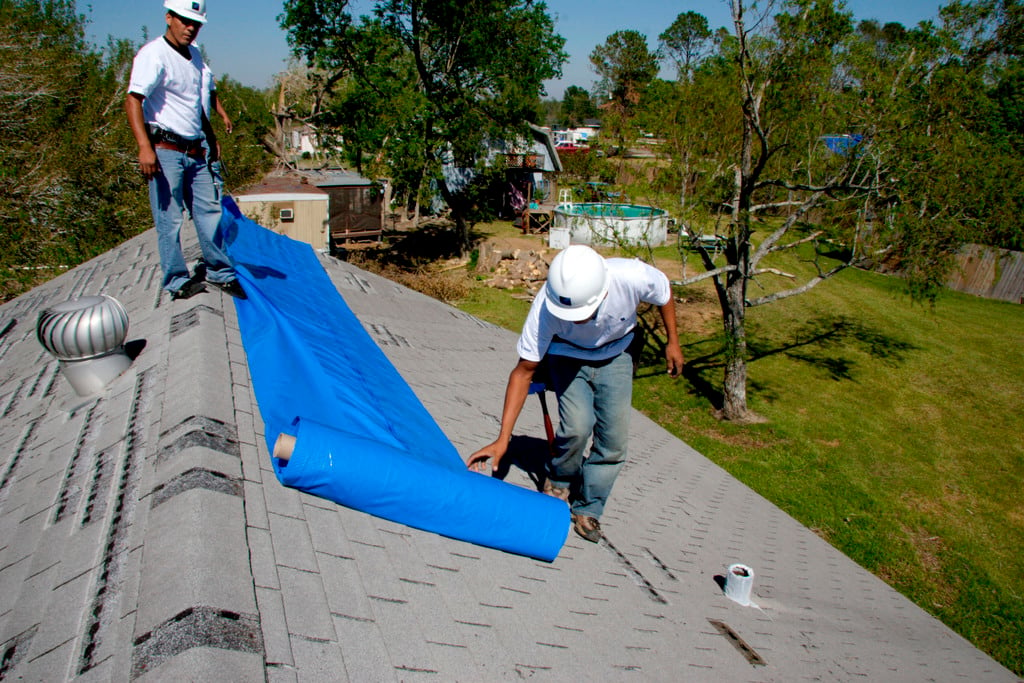Identify the Source of the Leak
First and foremost, locate the source of the leak. Start by inspecting your attic or the area directly beneath the roof. Look for visible water stains or damp spots. Use a flashlight to spot any breaches or damaged areas.
Contain the Leak
Once you’ve identified the source, contain the leak to minimize water damage. Place buckets or containers directly under the leaking area to catch the water. If the leak is significant, consider using a tarp or plastic sheeting to cover the affected area temporarily. Secure the tarp with heavy objects or duct tape to prevent it from blowing away.
Make Temporary Repairs
Next, address the leak with temporary fixes. If the leak is caused by a damaged shingle or tile, use roofing cement or a waterproof sealant to cover the affected area. For more significant damage, place a piece of plywood over the hole and secure it with nails or screws.
Dry Out the Area
Prevent mold growth and further damage by drying out the area. Use fans or dehumidifiers to reduce moisture levels. Ensure that all affected materials, including insulation and wood, are thoroughly dried.
Contact a Professional
While temporary fixes are essential, it’s crucial to consult a roofing professional as soon as possible. They can provide a permanent solution and ensure that the roof is repaired properly. Schedule an inspection to assess the extent of the damage and get a detailed repair plan.
Monitor the Area
After addressing the immediate concerns, keep an eye on the repaired area. Check for any signs of recurring leaks or damage. Regular inspections can help you catch any issues early and prevent future problems.
Prevent Future Leaks
To avoid future emergencies, perform routine maintenance on your roof. Clean gutters regularly to prevent blockages, inspect shingles for damage, and ensure that flashing around chimneys and vents is intact. A well-maintained roof is less likely to develop leaks.
How to Quickly Fix Roof Leaks During a Storm
During a storm, roof leaks can become an urgent issue. First, identify where the water is coming in. Use a flashlight to pinpoint the source of the leak. Next, cover the area with a waterproof tarp or plastic sheeting to protect your interior. Secure the covering with heavy objects or duct tape to ensure it stays in place. Inside, use buckets to catch drips and minimize water damage. After the storm, contact a professional roofer for a thorough inspection and permanent repair.
Steps to Control Roof Leaks Until Professional Help Arrives
When dealing with a roof leak, immediate action is vital. Begin by placing a container under the leak to catch water. Use a temporary sealant or roofing tape to cover the area of damage. If possible, use a piece of plywood or similar material to shield the leak. Ensure that the affected area is dried out to prevent mold growth. Contact a roofing specialist to arrange for a permanent fix as soon as possible.
Emergency Roof Leak Solutions for Homeowners
If you encounter a roof leak, start by finding the exact location of the leak. Inside the house, place containers to collect dripping water and prevent further damage. If it’s safe, go outside and cover the damaged area with a tarp or plastic sheeting. Secure it with weights to keep it in place. After making these temporary repairs, dry out the area with fans or dehumidifiers. Schedule a professional inspection to address the leak with a long-term solution.
Temporary Repairs for Roof Leaks During Winter
Winter conditions can exacerbate roof leaks. Begin by locating the leak and placing a container underneath to catch any water. Use a waterproof tarp to cover the affected area, and weigh it down to prevent wind from lifting it. Insulate the area to prevent further ice or snow damage. Inside, ensure that the area is dried thoroughly with heaters or fans. Consult a roofing expert to inspect and repair the roof as soon as the weather allows.
What to Do If Your Roof Springs a Leak Overnight
If you discover a roof leak overnight, act quickly to prevent damage. First, set up containers under the leak to catch the water. If the leak is significant, use a large plastic sheet or tarp to cover the area from the outside, securing it with weights or tape. Inside, keep the area dry using fans or a dehumidifier. Once the immediate situation is under control, contact a roofing professional to schedule a thorough inspection and repair.
 When a roof leak strikes unexpectedly, it’s crucial to act swiftly to prevent extensive damage. An
When a roof leak strikes unexpectedly, it’s crucial to act swiftly to prevent extensive damage. An